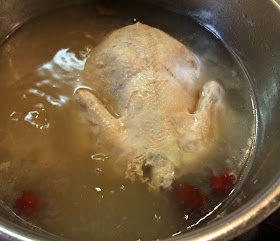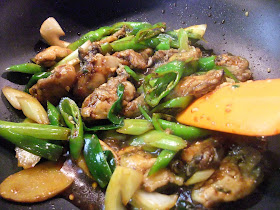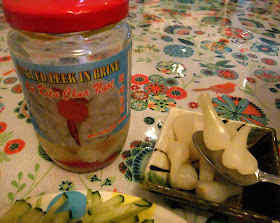Yum Tong... Cantonese saying for "Drink Soup". Whether you are coming down with a cold, under the weather, want to ward off ailments or hungover(?)... there is a soup for that. In Asia, particular China and Korea, soups are nourishment and medicine offered as one-pot meals for the family and as individual tonics. The range of ingredients can be anything from and in combination of chicken, fresh and dried vegetables, meats, bones, fish, seafood and carefully selected dried herbal concoctions. The Chinese believe that some soups cool in the summer and others give warmth in the winter, and then there is one's individual internal weather of yin and yang and the perpetual philosophy of balancing these opposing forces for harmony of health. When the internal body is off balance, outward bodily symptoms like sore throat, coughing, or dryness can appear. Here are some of our regular family favourites...
A simple soup made from a small chicken or cornish game hen cooked in water with some dried ju jubes/dates and ginseng could do wonders. That's really all there is to it. Chicken is nourishing, ginseng is known for its immune and energy boosting properties, and jujubes alleviates stress and prevents aging-- an elixir in a pot. Two hours on a soft boil is recommended for all soups to optimize on the flavours and to bring out the health properties from all the ingredients.
Chinese ginseng are usually sold dried and should be bought in a Chinese herbal shop whereas Korean fresh ginseng (insam) can be bought in the refrigerated section in a Korean supermarket. The jujubes provide a touch of contrasting sweetness to the chicken and ginseng, and can be purchased in the dried aisle of Asian supermarkets.
Two hours on medium with a pinch of salt yields a rich broth with an under tone of fragrant and sweet bitterness of ginseng. Skim fat on the surface before serving. You can eat the chicken though it can be dry, especially its white meat as all the moisture and flavour has been cooked into the soup.
A similar Korean soup ginseng chicken soup (Samgyetang) is eaten like a meal. Each small whole chicken is boiled in its own clay pot over the stove, then served boiling hot, directly at the table. Koreans will break up the chicken and rice in the pot so that it becomes a porridge. Considered a summer dish, it is eaten in restaurants and in the homes during the hottest days to help deal with the heat. It also makes a wonderful meal when you're fighting off a cold or flu. Ginseng (insam) is one of Korea's most famous products with its rejuvenating properties valued as a booster for the immune system. A source of energy and vitality, it also promotes longevity and increases libido.
 |
| ginseng chicken soup (Samgyetang) |
According to Chinese medicine, black silkie chicken soup helps to strengthen the immune system, brings down the deficient body heat and overall boosts your energy stores where they have been depleted. A great detoxification if you have been eating a lot of deep-fried and junkie foods. This is one I make at least once a month. Just one bowl can feel like wonders, if not just the warming effect it gives.
 |
| black silkie chicken soup |
The Chinese believe that these kind of slow-fire soups are not just soups but more like tonics. This is attributed to the concept of balance in one's body, that winter melon soup brings down heat in one's body and so is especially suitable in the hot weather. Although for me, this is an all-weather comfort and nourishing food. It is known to cool the internal heat, lowers blood pressure, promote yin and also helps to lose weight.
 |
| winter melon soup |
And if we are talking about hangovers, Korean spicy pork bone soup-- Gamjatang is famous for it's cure... maybe that's why these speciality soup shops are opened 24/7 in Korea as well as in Toronto's Korean towns :).
 |
| Gamjatang |
So what are you waiting for.... "Yum Tong!"
















































